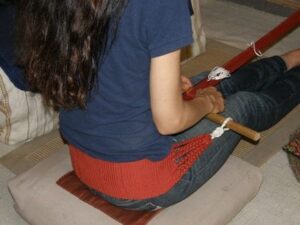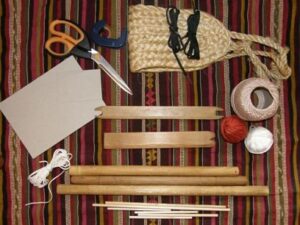Laverne Waddington: Backstrap Weaver to the World
By Cathy Koos
(unless otherwise noted, all photos courtesy L Waddington)
Thanks to the wonders of Zoom, I recently had an opportunity to chat with renowned backstrap weaver, Laverne Waddington, from her home in the tropics of Bolivia. Born in India, Laverne’s family emigrated to Australia when she was an infant. She has lived in South America for the past 30 years, adventuring, hiking, skiing, and mountain climbing, and during the off-season teaching English.

Figure 1 Torres del Paine, Patagonia Chile, Reddit
Textiles and crafts came to Laverne once the pressure was off in school, by exploring batik, knitting and fiber arts. Laverne soon discovered the international language of weaving and became captivated by the backstrap loom technology of the indigenous weavers.
Lavern found her first weaving tutor in the plaza in Cusco, Peru.
The Indigenous language is Quechua. While there are some language barriers in learning from the local weavers, Laverne said knowing the words for black, white, one, and two went a long way. Rather than hands-on teaching, the local weavers preferred for her to watch and learn.
Backstrap weaving looms are known in similar form throughout the world, with the weaver being an active part of the loom. A strap encircles the weaver, providing loom tension. The warp threads on the far end of the loom encircle a tree or a post, completing the tension. Sticks give the weaver an opportunity to manipulate the warp.
The looms of Bolivia are amazingly similar to the Montagnard Vietnamese hill tribe communities now living in North Carolina.

Laverne at her loom

Parts of a backstrap loom
When it is time to stop weaving for the day, the weaver simply steps out of the backstrap, removes the warp thread bundle from the post, and rolls the weaving up. Neatly tucked into a tote or basket, this is a very portable project.
Supplies were exceedingly difficult to acquire during the pandemic, so Laverne disciplined herself to use up her stash, with an occasional surprise addition. The lockdown also pushed her into using a drop spindle and her takli to produce her own threads.
While Laverne enjoys working with silk, there is plenty of fine, local cotton available in the tropics where she now lives.
Interestingly, the local weavers are switching to brightly colored acrylics catering to the tourist trade, rather than the softer colors produced by natural dye processes.
While women are traditionally the weavers, men are still seen walking and knitting the wool chullo or ear flap hats.
Laverne has gone beyond the traditional motifs learned from her mentors and expanded her weaving repertoire:




Some of Laverne’s projects
One unexpected gift from the pandemic was the expansion of Zoom, so don’t let your guild’s distance from Bolivia prevent you from learning; Laverne offers distance learning on the backstrap and Andean Pebble Weave.
Laverne has a large selection of books, videos and monographs available through Taproot Press https://www.taprootvideo.com/instructorClasses.jsf?iid=3
You can also find her on Facebook @LaverneWaddington” and on Instagram at “lavernewaddington.”
Laverne visited CNCH at our 2014 conference in Oakland and currently has no plans to teach here in the US. Instead, she offers online workshops. Contact her through her blog for more information, tutorials, https://backstrapweaving.wordpress.com/